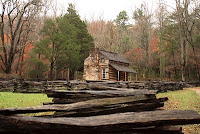So I will start by talking a little bit about each of the five Elements of Art individually. Each one individually can play a role in our work and our photographs and all have bearing on any artistic endeavor. The five elements are line, value, texture, shape and color.
I’ll begin today with line. Line can be a very powerful element so we must be conscious of how we use it. We will find it most easily seen in architecture; consider the lines of the fallen barn here.
 |
| Fallen |
 |
| The Fence Leads-John Oliver Cabin |
The lines of the fallen walls lead your eye directly to the crumpled roof. Or the fence rails in this photograph that lead you back to the cabin and backdrop of fall trees; all are clearly seen as lines and lead you through the frame of the photograph. This image of a railed walkway called "Follow the Light" where the light of the day catches the rail as it winds through the trees is also another good example of line in a photograph that creates a certain mood. Think about how they make you feel and what they do.
But nature also has line; you’ll see it in trees, waterfalls, roads and if you look closely most everything. Consider a group of trees that you might be lying on the ground to photograph such as the one here, the line of the tree trunks lead you to the glowing golden leaves above, pure heaven.
 | |
| Golden Glow |
 |
| Autumn's Pathway |
 | |||||||||||||||||||||||||||||||||||||||||||||||||||||||||||||||||||||||||||||||||||||||||||||||||||||||||||||||||||||||||||||||
| Eye of the Needle |
it winds and draws your eye into the rest of the photograph. How about in a more abstract photograph such as the one on the right; notice how the line plays a major role allowing the dew covered spider’s silk lead you through the eye of the needle.
Long exposure light photographs can do the same thing when what might appear to the human eye as a single head light or traffic lights becomes a single line with long exposure such as this photograph by Marc Barker.
There are certain attributes of line to consider. If the beginning of the line is too centrally located in the photo you lose the other half of the photograph...your eye never sees the part of the image before the line begins. Line can be strong or it can be sensual. It can be harsh or it can be pleasant. Think about the role it may or may not play in refining what you do and want to portray. Line and its use are all important when you consider: Where is the line leading you? Where are you taking the viewer? Are they seeing what you want them to see in the frame? Is it removing you from the frame or into it? What role does it play? Is it drawing focus or attention on the subject? How does it contribute to your overall desire to convey your point of view? How does it fit with your photography and what you want to convey? Should line take a strong role or subdued?
The idea of line itself may seem rather simplistic but combined with other elements can be a very powerful tool. You will definitely see its importance when we get to the principle of art in movement or variation. The idea of line, the width of it and how it varies, an outline if you will, is more interesting when it varies in width or it is missing entirely and your eye has to complete it. Rembrandt was a master of line. If you want to see how profound an effect line can have in a composition look at the work of some of these Masters, Rembrandt, Cezanne, Toulouse-Lautrec and Klee, even DaVinci’s drawings. Photographers who use line effectively, like in this stair spiral of Wm Cowger or Don Gale’s Bay Bridge in the Fog. Study its role in what you do. It seems simple but its power can be unmatched in a photograph or work of art.
To see addition examples of line in photographs of mine visit here: Flickr



No comments:
Post a Comment